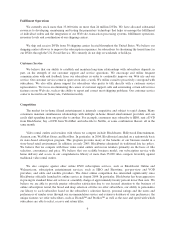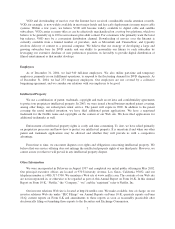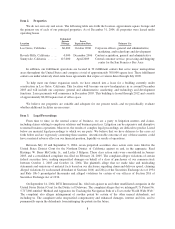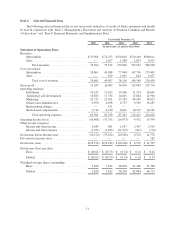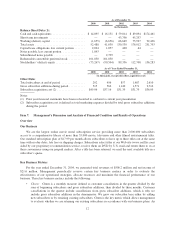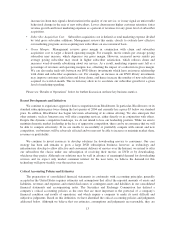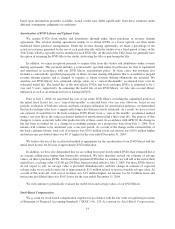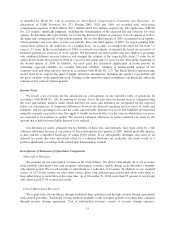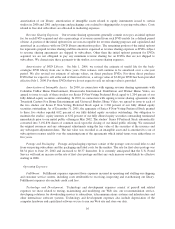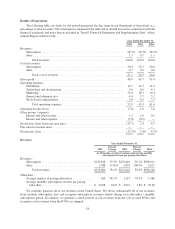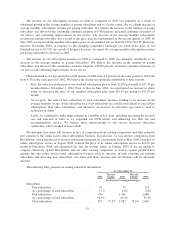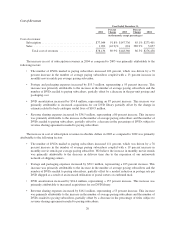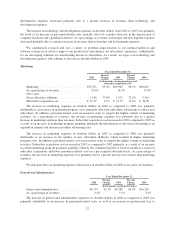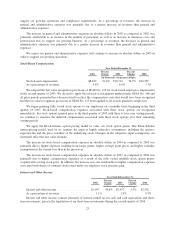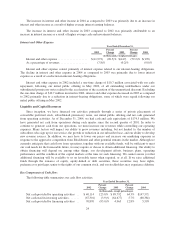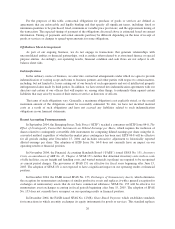NetFlix 2004 Annual Report Download - page 32
Download and view the complete annual report
Please find page 32 of the 2004 NetFlix annual report below. You can navigate through the pages in the report by either clicking on the pages listed below, or by using the keyword search tool below to find specific information within the annual report.amortization of our library, amortization of intangible assets related to equity instruments issued to certain
studios in 2000 and 2001 and postage and packaging costs related to shipping titles to paying subscribers. Costs
related to free-trial subscribers are allocated to marketing expenses.
Revenue Sharing Expenses. Our revenue sharing agreements generally commit us to pay an initial upfront
fee for each DVD acquired and also a percentage of revenue earned from such DVD rentals for a defined period
of time. A portion of the initial upfront fees are non-recoupable for revenue sharing purposes and capitalized and
amortized in accordance with our DVD library amortization policy. The remaining portion of the initial upfront
fee represents prepaid revenue sharing and this amount is expensed as revenue sharing expenses as DVDs subject
to revenue sharing agreements are shipped to subscribers. Other than the initial upfront payment for DVDs
acquired, we are not obligated to pay any minimum revenue sharing fee on DVDs that are not shipped to
subscribers. We characterize these payments to the studios as revenue sharing expenses.
Amortization of DVD Library. On July 1, 2004, we revised the estimate of useful life for the back-
catalogue DVD library from one to three years. New releases will continue to be amortized over a one-year
period. We also revised our estimate of salvage values, on direct purchase DVDs. For those direct purchase
DVDs that we expect to sell at the end of their useful lives, a salvage value of $3.00 per DVD has been provided
effective July 1, 2004. For those DVDs that we do not expect to sell, no salvage value is provided.
Amortization of Intangible Assets. In 2000, in connection with signing revenue sharing agreements with
Columbia TriStar Home Entertainment, Dreamworks International Distribution and Warner Home Video, we
agreed to issue to each of these studios our Series F Non-Voting Preferred Stock equal to 1.204 percent of our
fully diluted equity securities outstanding. In 2001, in connection with signing revenue sharing agreements with
Twentieth Century Fox Home Entertainment and Universal Studios Home Video, we agreed to issue to each of
the two studios our Series F Non-Voting Preferred Stock equal to 1.204 percent of our fully diluted equity
securities outstanding. As of December 31, 2001, the aggregate of Series F Non-Voting Preferred Stock granted
to these five studios equaled 6.02 percent of our fully diluted equity securities outstanding. Our obligation to
maintain the studios’ equity interests at 6.02 percent of our fully diluted equity securities outstanding terminated
immediately prior to our initial public offering in May 2002. The studios’ Series F Preferred Stock automatically
converted into 3,192,830 shares of common stock upon the closing of our initial public offering. We measured
the original issuances and any subsequent adjustments using the fair value of the securities at the issuance and
any subsequent adjustment dates. The fair value was recorded as an intangible asset and is amortized to cost of
subscription revenues ratably over the remaining term of the agreements which initial terms were either three or
five years.
Postage and Packaging. Postage and packaging expenses consist of the postage costs to mail titles to and
from our paying subscribers and the packaging and label costs for the mailers. The rate for first-class postage was
$0.34 prior to June 29, 2002 and increased to $0.37 thereafter. It is currently anticipated that the U.S. Postal
Service will seek an increase in the rate of first class postage and that any such increase would likely be effective
starting in 2006.
Operating Expenses:
Fulfillment. Fulfillment expenses represent those expenses incurred in operating and staffing our shipping
and customer service centers, including costs attributable to receiving, inspecting and warehousing our library.
Fulfillment expenses also include credit card fees.
Technology and Development. Technology and development expenses consist of payroll and related
expenses we incur related to testing, maintaining and modifying our Web site, our recommendation service,
developing solutions for downloading movies to subscribers, telecommunications systems and infrastructure and
other internal-use software systems. Technology and development expenses also include depreciation of the
computer hardware and capitalized software we use to run our Web site and store our data.
16


